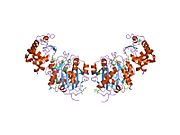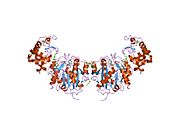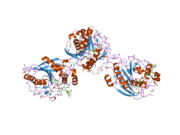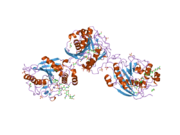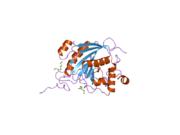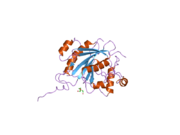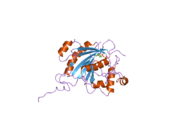B4GALT1
Beta-1,4-galactosyltransferase 1 is an enzyme that in humans is encoded by the B4GALT1 gene.[5][6]
This gene is one of seven beta-1,4-galactosyltransferase (beta4GalT) genes. They encode type II membrane-bound glycoproteins that appear to have exclusive specificity for the donor substrate UDP-galactose; all transfer galactose in a beta1,4 linkage to similar acceptor sugars: GlcNAc, Glc, and Xyl. Each beta4GalT has a distinct function in the biosynthesis of different glycoconjugates and saccharide structures. As type II membrane proteins, they have an N-terminal hydrophobic signal sequence that directs the protein to the Golgi apparatus and which then remains uncleaved to function as a transmembrane anchor. By sequence similarity, the beta4GalTs form four groups: beta4GalT1 and beta4GalT2, beta4GalT3 and beta4GalT4, beta4GalT5 and beta4GalT6, and beta4GalT7. This gene is unique among the beta4GalT genes because it encodes an enzyme that participates both in glycoconjugate and lactose biosynthesis. For the first activity, the enzyme adds galactose to N-acetylglucosamine residues that are either monosaccharides or the nonreducing ends of glycoprotein carbohydrate chains. The second activity is restricted to lactating mammary tissues where the enzyme forms a heterodimer with alpha-lactalbumin to catalyze UDP-galactose + D-glucose <=> UDP + lactose. The two enzymatic forms result from alternate transcription initiation sites and post-translational processing. Two transcripts, which differ only at the 5' end, with approximate lengths of 4.1 kb and 3.9 kb encode the same protein. The longer transcript encodes the type II membrane-bound, trans-Golgi resident protein involved in glycoconjugate biosynthesis. The shorter transcript encodes a protein which is cleaved to form the soluble lactose synthase.[6]
References
- ^ a b c GRCh38: Ensembl release 89: ENSG00000086062 – Ensembl, May 2017
- ^ a b c GRCm38: Ensembl release 89: ENSMUSG00000028413 – Ensembl, May 2017
- ^ "Human PubMed Reference:". National Center for Biotechnology Information, U.S. National Library of Medicine.
- ^ "Mouse PubMed Reference:". National Center for Biotechnology Information, U.S. National Library of Medicine.
- ^ Lo NW, Shaper JH, Pevsner J, Shaper NL (Aug 1998). "The expanding beta 4-galactosyltransferase gene family: messages from the databanks". Glycobiology. 8 (5): 517–26. doi:10.1093/glycob/8.5.517. PMID 9597550.
- ^ a b "Entrez Gene: B4GALT1 UDP-Gal:betaGlcNAc beta 1,4- galactosyltransferase, polypeptide 1".
Further reading
- Amado M, Almeida R, Schwientek T, Clausen H (2000). "Identification and characterization of large galactosyltransferase gene families: galactosyltransferases for all functions". Biochim. Biophys. Acta. 1473 (1): 35–53. doi:10.1016/S0304-4165(99)00168-3. PMID 10580128.
- Gerber AC, Kozdrowski I, Wyss SR, Berger EG (1979). "The charge heterogeneity of soluble human galactosyltransferases isolated from milk, amniotic fluid and malignant ascites". Eur. J. Biochem. 93 (3): 453–60. doi:10.1111/j.1432-1033.1979.tb12843.x. PMID 33805.
- Uejima T, Uemura M, Nozawa S, Narimatsu H (1992). "Complementary DNA cloning for galactosyltransferase associated with tumor and determination of antigenic epitopes recognized by specific monoclonal antibodies". Cancer Res. 52 (22): 6158–63. PMID 1384956.
- Lopez LC, Youakim A, Evans SC, Shur BD (1991). "Evidence for a molecular distinction between Golgi and cell surface forms of beta 1,4-galactosyltransferase". J. Biol. Chem. 266 (24): 15984–91. PMID 1714903.
- Mengle-Gaw L, McCoy-Haman MF, Tiemeier DC (1991). "Genomic structure and expression of human beta-1,4-galactosyltransferase". Biochem. Biophys. Res. Commun. 176 (3): 1269–76. doi:10.1016/0006-291X(91)90423-5. PMID 1903938.
- Aoki D, Appert HE, Johnson D, et al. (1990). "Analysis of the substrate binding sites of human galactosyltransferase by protein engineering". EMBO J. 9 (10): 3171–8. doi:10.1002/j.1460-2075.1990.tb07515.x. PMC 552046. PMID 2120039.
- Watzele G, Berger EG (1991). "Near identity of HeLa cell galactosyltransferase with the human placental enzyme". Nucleic Acids Res. 18 (23): 7174. doi:10.1093/nar/18.23.7174. PMC 332820. PMID 2124683.
- Kalyanaraman VS, Rodriguez V, Veronese F, et al. (1990). "Characterization of the secreted, native gp120 and gp160 of the human immunodeficiency virus type 1". AIDS Res. Hum. Retroviruses. 6 (3): 371–80. doi:10.1089/aid.1990.6.371. PMID 2187500.
- Pal R, Hoke GM, Sarngadharan MG (1989). "Role of oligosaccharides in the processing and maturation of envelope glycoproteins of human immunodeficiency virus type 1". Proc. Natl. Acad. Sci. U.S.A. 86 (9): 3384–8. doi:10.1073/pnas.86.9.3384. PMC 287137. PMID 2541446.
- Dewar RL, Vasudevachari MB, Natarajan V, Salzman NP (1989). "Biosynthesis and processing of human immunodeficiency virus type 1 envelope glycoproteins: effects of monensin on glycosylation and transport". J. Virol. 63 (6): 2452–6. PMC 250699. PMID 2542563.
- Kozarsky K, Penman M, Basiripour L, et al. (1989). "Glycosylation and processing of the human immunodeficiency virus type 1 envelope protein". J. Acquir. Immune Defic. Syndr. 2 (2): 163–9. PMID 2649653.
- Robinson WE, Montefiori DC, Mitchell WM (1988). "Evidence that mannosyl residues are involved in human immunodeficiency virus type 1 (HIV-1) pathogenesis". AIDS Res. Hum. Retroviruses. 3 (3): 265–82. doi:10.1089/aid.1987.3.265. PMID 2829950.
- Appert HE, Rutherford TJ, Tarr GE, et al. (1986). "Isolation of galactosyltransferase from human milk and the determination of its N-terminal amino acid sequence" (PDF). Biochem. Biophys. Res. Commun. 138 (1): 224–9. doi:10.1016/0006-291X(86)90269-X. hdl:2027.42/26099. PMID 3091013.
- Appert HE, Rutherford TJ, Tarr GE, et al. (1986). "Isolation of a cDNA coding for human galactosyltransferase" (PDF). Biochem. Biophys. Res. Commun. 139 (1): 163–8. doi:10.1016/S0006-291X(86)80094-8. PMID 3094506.
- Furukawa K, Roth S, Sawicki J (1987). "Several Galactosyltransferase Activities Are Associated with Mouse Chromosome 17". Genetics. 114 (3): 983–91. PMC 1203025. PMID 3098628.
- Masri KA, Appert HE, Fukuda MN (1989). "Identification of the full-length coding sequence for human galactosyltransferase (beta-N-acetylglucosaminide: beta 1,4-galactosyltransferase)". Biochem. Biophys. Res. Commun. 157 (2): 657–63. doi:10.1016/S0006-291X(88)80300-0. PMID 3144273.
- Roth J, Lentze MJ, Berger EG (1985). "Immunocytochemical demonstration of ecto-galactosyltransferase in absorptive intestinal cells". J. Cell Biol. 100 (1): 118–25. doi:10.1083/jcb.100.1.118. PMC 2113462. PMID 3917437.
- Roth J, Berger EG (1982). "Immunocytochemical localization of galactosyltransferase in HeLa cells: codistribution with thiamine pyrophosphatase in trans-Golgi cisternae". J. Cell Biol. 93 (1): 223–9. doi:10.1083/jcb.93.1.223. PMC 2112114. PMID 6121819.
- Chatterjee SK, Mukerjee S, Tripathi PK (1995). "Analysis of the sequences of human beta-1,4-galactosyltransferase cDNA clones". Int. J. Biochem. Cell Biol. 27 (3): 329–36. doi:10.1016/1357-2725(94)00062-G. PMID 7540104.
- Kudo T, Narimatsu H (1995). "The beta 1,4-galactosyltransferase gene is post-transcriptionally regulated during differentiation of mouse F9 teratocarcinoma cells". Glycobiology. 5 (4): 397–403. doi:10.1093/glycob/5.4.397. PMID 7579794.
External links
- GeneReviews/NCBI/NIH/UW entry on Congenital Disorders of Glycosylation Overview
- Human B4GALT1 genome location and B4GALT1 gene details page in the UCSC Genome Browser.










